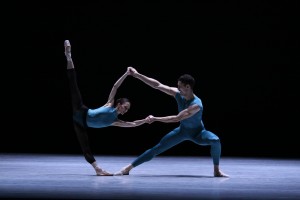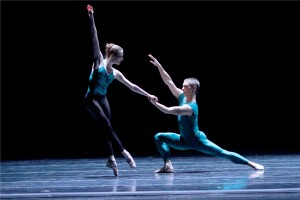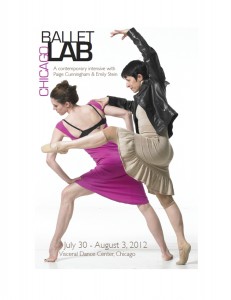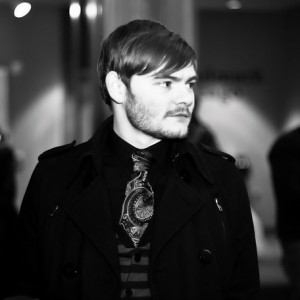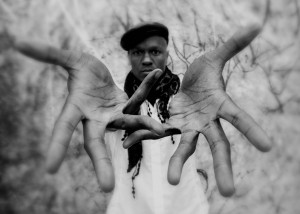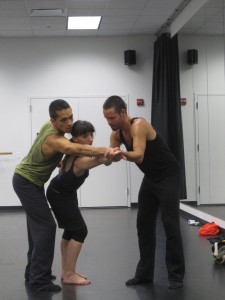[simple_slideshow]
The studios at Hubbard Street Dance Chicago (HSDC) were eerily quiet last week. The dancers were on a well-deserved break and the staff was holed up in their offices busily preparing for the upcoming season (rehearsals started yesterday). Fresh off a three-week trip to Costa Rica, dancer Jesse Bechard agreed to meet with me before taking an afternoon ballet class. After spending an hour chatting with the 31-year-old, this is what I know. He’s smart, funny, loyal, curious, an avid reader, and a self-proclaimed news junkie. He plays drums, he loves kale – and, let’s be honest – he’s pretty easy on the eyes.
Bechard grew up in the Northeast (Connecticut, Massachusetts) and cites seeing Baryshnikov dance on tv as his impetus to start dancing. Here’s the Cliff Notes of his early career: danced in various Nutcrackers and recitals; quit dancing during the middle schools years to focus on academics and play sports like soccer, basketball and lacrosse; started dancing again at 16/junior year of high school; went to Walnut Hill School for the Arts for his senior year; attended Boston Ballet summer programs; quit dancing again to go to college (one year at University of Chicago); moved to New York City to dance (and wait tables); apprenticed with Ballet Austin for a year; joined Richmond Ballet in Virginia where he danced for eight years. Whew! “I didn’t have that much exposure when I was growing up dancing,” he said. “The things that were put in front of me as goals were all these white tights things. I didn’t know what was going on in Europe. I’d seen Hubbard Street, but I didn’t know about NDT (Nederlands Dans Theater). In the early 2000’s I went to see NDTII and that really changed my trajectory substantially. ‘Well, there it is! That’s what I’d like to do.’ I remember the next day in class, my whole motivation and what I was focusing on had really shifted overnight. I never really had that much of a desire to be the prince at all. You always idolize Baryshnikov. He’s beautiful. He does incredible things. But I don’t think I was built for that. It’s an interesting point when you come to the realization of what you want to do and what your body is aesthetically built for.”
The “third time is a charm” adage rang true to for Bechard and his bumpy adventure to reach HSDC. He auditioned for three times before everything worked out. The beginning of the financial crisis, other contract obligations and lack off an opening in the company all delayed his debut with HSDC until August of 2010. In 2011, Bechard performed at the Chicago Dancing Festival (CDF) for the Moderns (Sharon Eyal and Gai Behar’s Too Beaucoup) and Masters (Jiri Kylían’s Petite Mort) programs. This year he’s scheduled to perform Twyla Tharp’s Scarlatti in the Chicago Dancing program on Monday, August 20, and Ohad Naharin’s Tabula Rasa in the closing night’s Celebration of Dance on Saturday, August 25. (Casting may change.) Here are some excerpts from our chat.
The first thing I remember seeing you in was Nacho Duato’s Arcangelo. Since then, it seems like you’ve been in everything. Who were some of your favorite choreographers to work with or favorite pieces?
Nacho was really fun to work with. It was really fun to work with Yoshi (Fumi Inao), who came to set Ohad’s (Naharin) work. “Too Beaucoup” was a really difficult process for me. I was new. I’d only been in the company six months at that point and certain things, like Nacho’s piece were within my comfort zone. Then we come in and have this crazy Israeli woman dancing around asking you what you got out of that. You get to a point in this company where you get much better at learning the way that things operate. It’s not often in a ballet company that someone will come in and do something and ask what you got from it, so you learn a lot more how to interpret what you do. We do a massive amount of improvisation. If you make it up and it looks convincing, it will probably work. It’s true. If you’re tentative and hesitant, that reads. But if you’re like this is what I’m going to do, that’s a choice. It really doesn’t have to be right, it just has to be what you intend to do. You can take risks and something can happen that you didn’t intend, but you have to make it happen. As you get more comfortable with that it becomes more enjoyable. In her process, I was not quite used to that and her movement style is…insane. The process was cool, but it wasn’t my favorite process, but now it is one of my favorite pieces to perform in terms of the visceral experience as a dancer. You’re in this unitard, you have contacts on, you have a wig on, you’re dancing to this killer music with these awesome lights and you’re just one little cog in the wheel. It’s awesome for your brain. You’re just in there, talking to yourself. You have to count everything. There’s 9 of these and 14 of these and 12 of these. I think that’s the piece with the biggest difference between how much I enjoy doing it and how much I enjoyed the process. I love Sharon and Gai, they were really cool, but the process was really hard.
“Petite Mort” (Jirí Kylían) – that’s another thing you want to check off the list in your dance career. That’s one that for most dancers, you really, really want to do. It’s almost a perfect piece. It’s concise, it’s short. It’s not overdone. It is so insanely musical and so simple. The whole men’s section…getting six guys to breathe together.
When you all turn around that first time and swipe the sword…it’s such a great moment.
That’s definitely one of the most stressful things…walking down with it balanced on your finger. Finding that balance point is difficult. You get good at it, but when the curtain opens up, there is a shift in air and then you’re trying to walk backwards, downstage and find your mark and look at the other person, then lower your sword down and as you lower it, trying to keep it balanced on your finger. I love dancing in silence with only the sounds of the swords. There’s such a cool internal rhythm to it.
Alejandro’s (Cerrudo) stuff feels really good to do. The movement feels really nice.
Does his work become shorthand after a while, since you’ve worked with him so much?
It becomes much easier to know what he wants. I think it’s like that with a lot of choreographers. You know what they like to see. Not even what they like to see, it’s not about ass-kissing or pleasing someone, but you kind of have an idea of what aesthetic they’re shooting for, so you can just get to it quicker.
The Forsythe piece in the Summer Series was amazing. You were in both casts. How did you get through that week?
It was really difficult. That was a hard program. I drank a lot of Pedialyte.
What was the learning process like for Quintett?
The people that he sent – Thomas (McManus), Stephen (Galloway) and Dana (Caspersen) – they were fantastic. None of us really knew what to expect when they came in. That process was great. I really enjoyed working with them. I think what Thomas was asking me to do and trying to get out of me and everybody felt massively different from the beginning to the end. And then it felt massively different from when we did it here and at ADF.
Did you get to meet William Forsythe at the American Dance Festival?
Yeah, he worked with us. He comes in wearing jean, sneakers and a tee shirt. He’s a totally quirky, awesome, incredibly laid-back guy. I’ve heard that he can really not be that way, but anyone who is trying to create something can go a little crazy. He wasn’t like “Forsythe”. He was joking about himself and totally mellow. He was super encouraging. In that piece, because of the nature of the music and the movement, you really are supposed to go for it as much as you can. And if something happens that didn’t happen before? See where it goes.
At the Harris, I’m pretty sure I saw you slide off the stage at one point.
I fell at one point. I was running and sliding and hit a tape mark. But honestly, that could be the movement.
There was something different about that work. Even in rehearsals, if was the first time I saw you guys laughing and having fun in rehearsal. Not that you don’t have fun, but everyone seemed really laid back and you seemed to be having such a good time, especially on stage.
It makes you smile. We don’t have a lot of smiling pieces. It feels like that when you’re doing it. We weren’t putting that on. In rehearsals, you’re kind of like – gasp! – dying, but on stage, it makes you smile. The fact that it was made right after his first wife passed away, you thought it was sort of memorial, but it’s a celebration of life and memory. Working with them there was no stress. There was so much respect.
So, Twyla. What was it like working with her?
It’s another one of these “icon” people. She was great. She was super fun to work with. She a little ball of energy. She could power a city. She 71 now. She was jumping on me and wrapping herself around me – totally off the floor. I’m there with Twyla hanging off of me thinking ‘I can’t drop her. This is a lawsuit waiting to happen.’ She’s so professional and has such a specific style and procedure of working. She’s a workhorse. She didn’t take lunch. She would have lunch brought to her and stagger our lunches, so we could have lunch, but she could continue working throughout the day.
How is dancing Scarlatti?
It’s a fun piece to do. It’s entirely different than “Quintett”. In “Quintett”, you want to really throw yourself at it. “Scarlatti”, you throw yourself at it too, but there are parts that are much lighter on the floor. It is super musical, so it’s fun to dance. I think it’s exactly what she intended it to be. It exactly fits the music. I’d like to work with her again.
Chicago Dancing Festival 2012 runs August 20 – 25. For more information, visit chicagodancingfestival.com.
Slideshow Photo Credits:
Bechard with Ana Lopez in Jirí Kylían’s “Petite Mort”. Photo by Cheryl Mann.
Bechard in “Arcangelo” rehearsal with Penny Saunders and Nacho Duato. Photo by Igor Larin.
Bechard headshot by Cheryl Mann.
Bechard in Jonathan Fredrickson’s “Untitled Landscape”. Photo by Todd Rosenberg.
Bechard and Penny Saunders in William Forsythe’s “Quintett”. Photo by Cheryl Mann.
Bechard and Jacqueline Burnett in Alejandro Cerrudo’s “Malditos”. Photo by Todd Rosenberg.
Bechard and Ana Lopez in Alejandro Cerrudo’s “Little Mortal Jump”. Photo by Todd Rosenberg.
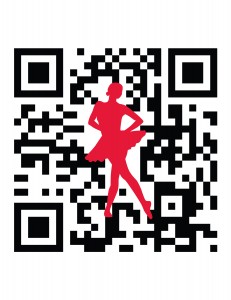 The Chicago Dancing Festival (CDF) kicked off its sixth year with a performance showcasing local talent. CDF Board Chair David Herro welcomed the audience and took a few minutes to talk about the origins of the fest and its mission. He said it’s threefold: 1) to make Chicago a national and international dance destination, 2) to keep elevating the dance form and building an audience by providing the best dance at the lowest possible cost – free!, and 3) to provide a forum, a place where these dancers can come together and watch each other perform. Mission accomplished.
The Chicago Dancing Festival (CDF) kicked off its sixth year with a performance showcasing local talent. CDF Board Chair David Herro welcomed the audience and took a few minutes to talk about the origins of the fest and its mission. He said it’s threefold: 1) to make Chicago a national and international dance destination, 2) to keep elevating the dance form and building an audience by providing the best dance at the lowest possible cost – free!, and 3) to provide a forum, a place where these dancers can come together and watch each other perform. Mission accomplished.
